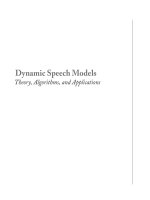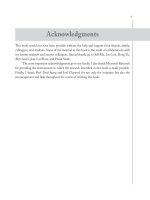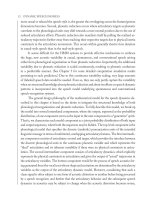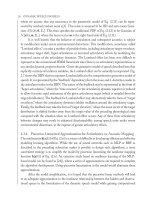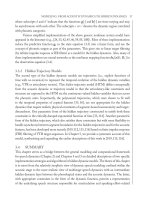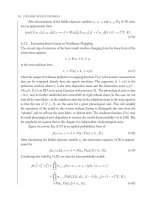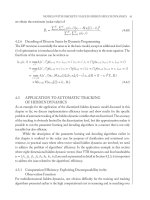Dynamic Speech ModelsTheory, Algorithms, and Applications phần 7 pps
Bạn đang xem bản rút gọn của tài liệu. Xem và tải ngay bản đầy đủ của tài liệu tại đây (1.13 MB, 11 trang )
P1: IML/FFX P2: IML
MOBK024-04 MOBK024-LiDeng.cls May 30, 2006 15:30
MODELS WITH DISCRETE-VALUED HIDDEN SPEECH DYNAMICS 61
we obtain the reestimate (scalar value) of
ˆ
D
s
=
N
t=1
C
i=1
γ
t
(s, i)
[
o
t
− H
s
x
t
[i] −h
s
]
2
N
t=1
C
i=1
γ
t
(s, i)
. (4.60)
4.2.6 Decoding of Discrete States by Dynamic Programming
The DP recursion is essentially the same as in the basic model, except an additional level (index
k) of optimization is introduced due to the second-order dependency in the state equation. The
final form of the recursion can be written as
δ
t+1
(s, i) = max
s
,i
δ
t
(s
, i
)p(s
t+1
= s, i
t+1
= i | s
t
= s
, i
t
= i
)p(o
t+1
|s
t+1
= s, i
t+1
= i)
≈ max
s
,i
δ
t
(s
, i
)p(s
t+1
= s |s
t
= s
)p(i
t+1
= i |i
t
= i
)p(o
t+1
|s
t+1
= s, i
t+1
= i)
= max
s
,i
, j,k
δ
t
(s
, i
)π
s
s
N(x
t+1
[i]; 2r
s
x
t
[ j] −r
2
s
x
t−1
[k] + (1 −r
s
)
2
T
s
, B
s
)
×N(o
t+1
; F(x
t+1
[i]) +h
s
, D
s
). (4.61)
4.3 APPLICATION TO AUTOMATIC TRACKING
OF HIDDEN DYNAMICS
As an example for the application of the discretized hidden dynamic model discussed in this
chapter so far, we discuss implementation efficiency issues and show results for the specific
problem of automatic trackingof the hidden dynamicvariables that are discretized. The accuracy
of the tracking is obviously limited by the discretization level, but this approximation makes it
possible to run the parameter learning and decoding algorithms in a manner that is not only
tractable but also efficient.
While the description of the parameter learning and decoding algorithms earlier in
this chapter is confined to the scalar case for purposes of clarification and notational con-
venience, in practical cases where often vector valued hidden dynamics are involved, we need
to address the problem of algorithms’ efficiency. In the application example in this section
where eight-dimensional hidden dynamic vectors (four VTR frequencies and four bandwidths
x = ( f
1
, f
2
, f
3
, f
4
, b
1
, b
2
, b
3
, b
4
)) are used as presented in detail inSection 4.2.3,it is important
to address the issue related to the algorithms’ efficiency.
4.3.1 Computation Efficiency: Exploiting Decomposability in the
Observation Function
For multidimensional hidden dynamics, one obvious difficulty for the training and tracking
algorithms presented earlier is the high computational cost in summing and in searching over
P1: IML/FFX P2: IML
MOBK024-04 MOBK024-LiDeng.cls May 30, 2006 15:30
62 DYNAMIC SPEECH MODELS
the huge space in the quantized hidden dynamic variables. The sum with C terms as required
in the various reestimation formulas and in the dynamic programming recursion is typically
expensive since C is very large. With scalar quantization for each of the eight VTR dimensions,
the C would be the Cartesian product of the quantization levels for each of the dimensions.
To overcome this difficulty, a suboptimal, greedy technique is implemented as described
in [110]. This technique capitalizes on the decomposition property of the nonlinear mapping
function from VTR to cepstra that we described earlier in Section 4.2.3. This enables a much
smaller number of terms to be evaluated than the rigorous number determined as the Cartesian
product, which we elaborate below.
Let us consider an objective function F, to be optimized with respect to M noninteracting
or decomposable variables that determine the function’s value. An example is the following
decomposable function consisting of M terms F
m
, m = 1, 2, ,M, each of which contains
independent variables (α
m
) to be searched for:
F =
M
m=1
F
m
(α
m
).
Note that the VTR-to-cepstrum mapping function, which was derived to be Eq. (4.46)
as the observation equation of the dynamic speech model (extended model), has this de-
composable form. The greedy optimization technique proceeds as follows. First, initialize
α
m
, m = 1, 2, ,M to reasonable values. Then, fix all α
m
s except one, say α
n
, and optimize
α
n
with respect to the new objective function of
F −
n−1
m=1
F
m
(α
m
) −
M
m=n+1
F
m
(α
m
).
Next, after the low-dimensional, inexpensive search problem for
ˆ
α
n
is solved, fix it and
optimize a new α
m
, m = n. Repeat this for all α
m
s . Finally, iterate the above process until all
optimized α
m
s become stabilized.
In the implementation of this technique for VTR tracking and parameter estimation as
reported in [110], each of the P = 4 resonances is treated as a separate, noninteractive variables
to optimize. It was found that only two to three overall iterations above are already sufficient to
stabilize the parameter estimates. (During the training of the residual parameters, these inner
iterations are embedded ineach of the outer EM iterations.) Also, it wasfound thatinitialization
of all VTR variables to zero gives virtually the same estimates as those by more carefully thought
initialization schemes.
With the use of the above greedy, suboptimal technique instead of full optimal search,
the computation cost of VTR tracking was reduced by over 4000-fold compared with the
brute-force implementation of the algorithms.
P1: IML/FFX P2: IML
MOBK024-04 MOBK024-LiDeng.cls May 30, 2006 15:30
MODELS WITH DISCRETE-VALUED HIDDEN SPEECH DYNAMICS 63
4.3.2 Experimental Results
As reported in [110], the above greedy technique was incorporated into the VTR tracking
algorithm and into the EM training algorithm for the nonlinear-prediction residual parameters.
The state equation was made simpler than the counterpart in the basic or extended model in
that all the phonological states s are tied. This is because for the purposes of tracking hidden
dynamics there is no need to distinguish the phonological states. The DP recursion in the more
general case of Eq. (4.33) can then be simplified by eliminating the optimization on index s ,
leaving only the indices i and j of the discretization levels in the hidden VTR variables during
the DP recursion. We also set the parameter r
s
= 1 uniformly in all the experiments. This gives
the role of the state equation as a “smoothness” constraint.
The effectiveness of the EM parameter estimation, Eqs. (4.57) and (4.60) in particular,
discussed for the extended model in this chapter will be demonstrated in the VTR tracking
experiments. Due to the tying of the phonological states, the training does not require any
data labeling and is fully unsupervised. Fig. 4.4 shows the VTR tracking ( f
1
, f
2
, f
3
, f
4
) results,
FIGURE 4.4: VTR tracking by setting the residual mean vector to zero
P1: IML/FFX P2: IML
MOBK024-04 MOBK024-LiDeng.cls May 30, 2006 15:30
64 DYNAMIC SPEECH MODELS
superimposed on the spectrogram of a telephone speech utterance (excised fromthe Switchboard
database) of “the way you dress” by a male speaker, when the residual mean vector h (tied over
all s state) was set to zero and the covariance matrix D is set to be diagonal with empirically
determined diagonal values. [The initialized variances are those computed from the codebook
entries that are constructed from quantizing the nonlinear function in Eq. (4.46.)] Setting h
to zero corresponds to the assumption that the nonlinear function of Eq. (4.46) is an unbiased
predictor of the real speech data in the form of linear cepstra. Under this assumption we observe
from Fig. 4.4 that while f
1
and f
2
are accurately tracked through the entire utterance, f
3
and
f
4
are incorrectly tracked during the later half of the utterance. (Note that the many small step
jumps in the VTR estimates are due to the quantization of the VTR frequencies.) One iteration
of the EM training on the residual mean vector and covariance matrix does not correct the
errors (see Fig. 4.5), but two iterations are able to correct the errors in the utterance for about
20 frames (after time mark of 0.6 s in Fig. 4.6). One further iteration is able to correct almost
all errors as shown in Fig. 4.7.
FIGURE 4.5: VTR tracking with one iteration of residual training
P1: IML/FFX P2: IML
MOBK024-04 MOBK024-LiDeng.cls May 30, 2006 15:30
MODELS WITH DISCRETE-VALUED HIDDEN SPEECH DYNAMICS 65
FIGURE 4.6: VTR tracking with two iterations of residual training
To examine the quantitative behavior of the residual parameter training, we list the log-
likelihood score as a function of the EM iteration number in Table 4.2. Three iterations of the
training appear to have reached the EM convergence. When we examine the VTR tracking
results after 5 and 20 iterations, they are found to be identical to Fig. 4.7, consistent with the
near-constant converging log-likelihood score reached after three iterations of training. Note
that the regions in the utterance where the speech energy is relatively low are where consonantal
constriction or closure is formed; e.g., near time mark of 0.1 s for /w/ constriction and near
time mark of 0.4 s for /d/ closure). The VTR tracker gives almost as accurate estimates for the
resonance frequencies in these regions as for the vowel regions.
4.4 SUMMARY
This chapter discusses one of the two specific types of hidden dynamic models in this book,
as example implementations of the general modeling and computational scheme introduced in
Chapter 2. The essence of the implementation described in this chapter is the discretization
P1: IML/FFX P2: IML
MOBK024-04 MOBK024-LiDeng.cls May 30, 2006 15:30
66 DYNAMIC SPEECH MODELS
FIGURE 4.7: VTR tracking with three iterations of residual training
TABLE 4.2: Log-likelihood Score as a Function of the EM
Iteration Number in Training the Nonlinear-prediction Resid-
ual Parameters
EM ITERATION LOG-LIKELIHOOD
NO. SCORE
0 1.7680
1 2.0813
2 2.0918
3 2.1209
5 2.1220
20 2.1222
P1: IML/FFX P2: IML
MOBK024-04 MOBK024-LiDeng.cls May 30, 2006 15:30
MODELS WITH DISCRETE-VALUED HIDDEN SPEECH DYNAMICS 67
of the hidden dynamic variables. While this implementation introduces approximations to
the original continuous-valued variables, the otherwise intractable parameter estimation and
decoding algorithms have become tractable, as we have presented in detail in this chapter.
This chapter starts by introducing the “basic” model, where the state equation in the
dynamic speech model gives discretized first-order dynamics and the observation equation is a
linear relationship between the discretized hidden dynamic variables and the acoustic observa-
tion variables. Probabilistic formulation of the model is presented first, which is equivalent to
the state–space formulation but is in a form that can be more readily used in developing and
describing the model parameter estimation algorithms. The parameter estimation algorithms
are presented, with sufficient detail in deriving all the final reestimation formulas as well as the
key intermediate quantities such as the auxiliary function in the E-step of the EM algorithm.
In particular, we separate the forward–backward algorithm out of the general E-step derivation
in a new subsection to emphasize its critical role. After deriving the reestimation formulas for
all model parameters as the M-step, we describe a DP-based algorithm for jointly decoding
the discrete phonological states and the hidden dynamic “state,” the latter constructed from
discretization of the continuous variables.
The chapter is followed by presenting an extension of the basic model in two aspects.
First, the state equation is extended from the first-order dynamics to the second-order dy-
namics, making the shape of the temporally unfolded “trajectories” more realistic. Second, the
observation equation is extended from the linear mapping to a nonlinear one. A new subsection
is then devoted to a special construction of the nonlinear mapping where a “physically” based
prediction function is developed when the hidden dynamic variables as the input are taken to
be the VTRs and the acoustic observations as the output are taken to be the linear cepstral
features. Using this nonlinear mapping function, we proceed to develop the E-step and M-step
of the EM algorithm for this extended model in a way parallel to that for the basic model.
Finally, we give an application example of the use of a simplified version of the extended
model and the related algorithms discussed in this chapter for automatic tracking of the hidden
dynamic vectors, the VTR trajectories in this case. Specific issues related to the tracking algo-
rithm’s efficiency arising from multidimensionality in the hidden dynamics are addressed, and
experimental results on some typical outputs of the algorithms are presented and analyzed.
P1: IML/FFX P2: IML
MOBK024-04 MOBK024-LiDeng.cls May 30, 2006 15:30
68
P1: IML/FFX P2: IML
MOBK024-05 MOBK024-LiDeng.cls April 26, 2006 14:3
69
CHAPTER 5
Models with Continuous-Valued
Hidden Speech Trajectories
The preceding chapter discussed the implementation strategy for hidden dynamic models based
on discretizing the hidden dynamic values. This permits tractable but approximate learning of
the model parameters and decoding of the discrete hidden states (both phonological states
and discretized hidden dynamic “states”). This chapter elaborates on another implementation
strategy where the continuous-valued hidden dynamics remainunchanged but a different type of
approximation is used. This implementation strategy assumes fixed discrete-state (phonological
unit) boundaries, which may be obtained initially from a simpler speech model set such as the
HMMs and then be further refined after the dynamic model is learned iteratively. We will
describe this new implementation and approximation strategy for a hidden trajectory model
(HTM) where the hidden dynamics are defined as an explicit function of time instead of by
recursion. Other types of approximation developed for the recursively defined dynamics can be
found in [84,85,121–123] and will not be described in this book.
This chapter extracts, reorganizes, and expands the materials published in [109,115,116,
124], fitting these materials into the general theme of dynamic speech modeling in this book.
5.1 OVERVIEW OF THE HIDDEN TRAJECTORY MODEL
As a special type of the hidden dynamic model, the HTM presented in this section is a struc-
tured generative model, from the top level of phonetic specification to the bottom level of
acoustic observations via the intermediate level of (nonrecursive) FIR-based target filtering that
generates hidden VTR trajectories. One advantage of the FIR filtering is its natural handling of
the two constraints (segment-bound monotonicity and target-directedness) that often requires
asynchronous segment boundaries for the VTR dynamics and for the acoustic observations.
This section is devoted to the mathematical formulation of the HTM as a statistical
generative model. Parameterization of the model is detailed here, with consistent notations set
up to facilitate the derivation and description of algorithmic learning of the model parameters
presented in the next section.
P1: IML/FFX P2: IML
MOBK024-05 MOBK024-LiDeng.cls April 26, 2006 14:3
70 DYNAMIC SPEECH MODELS
5.1.1 Generating Stochastic Hidden Vocal Tract Resonance Trajectories
The HTM assumes that each phonetic unit is associated with a multivariate distribution of
the VTR targets. (There are exceptions for several compound phonetic units, including diph-
thongs and affricates, where two distributions are used.) Eachphone-dependent target vector,t
s
,
consists of four low-order resonance frequencies appended by their corresponding bandwidths,
where s denotes the segmental phoneunit. The target vectoris a random vector—hencestochas-
tic target—whose distribution is assumed to be a (gender-dependent) Gaussian:
p(t |s) = N(t; μ
T
s
, Σ
T
s
). (5.1)
The generative process in the HTM starts by temporal filtering the stochastic targets.
This results in a time-varying pattern of stochastic hidden VTR vectors z(k). The filter is
constrained so that the smooth temporal function of z(k) moves segment-by-segment towards
the respective target vector t
s
but it may or may not reach the target depending on the degree
of phonetic reduction.
These phonetic targets are segmental in that they do not change over the phone segment
once the sample is taken, and they are assumed to be largely context-independent. In our HTM
implementation, the generation of the VTR trajectories from the segmental targets is through
a bidirectional finite impulse response (FIR) filtering. The impulse response of this noncausal
filter is
h
s
(k) =
⎧
⎪
⎨
⎪
⎩
c γ
−k
s (k)
−D < k < 0,
ck= 0,
c γ
k
s (k)
0 < k < D,
(5.2)
where k represents time frame (typically with a length of 10 ms each), and γ
s (k)
is the segment-
dependent “stiffness” parameter vector, one component for each resonance. Each component
is positive and real-valued, ranging between zero and one. In Eq. (5.2), c is a normalization
constant, ensuring that h
s
(k) sums to one over all time frames k. The subscript s (k)inγ
s (k)
indicates that the stiffness parameter is dependent on the segment state s (k), which varies
over time. D in Eq. (5.2) is the unidirectional length of the impulse response, representing the
temporal extent of coarticulation in one temporal direction, assumed for simplicity to be equal
in length for the forward direction (anticipatory coarticulation) and the backward direction
(regressive coarticulation).
In Eq. (5.2), c is the normalization constant to ensure that the filter weights add up to
one. This is essential for the model to produce target undershooting, instead of overshooting.
To determine c, we require that the filter coefficients sum to one:
D
k=−D
h
s
(k) = c
D
k=−D
γ
|k|
s (k)
= 1. (5.3)
P1: IML/FFX P2: IML
MOBK024-05 MOBK024-LiDeng.cls April 26, 2006 14:3
MODELS WITH CONTINUOUS-VALUED HIDDEN SPEECH TRAJECTORIES 71
For simplicity, we make the assumption that over the temporal span of −D ≤ k ≤ D, the
stiffness parameter’s value stays approximately constant
γ
s (k)
≈ γ.
That is, the adjacent segments within the temporal span of 2D +1 in length that contribute
to the coarticulated home segment have the same stiffness parameter value as that of the home
segment. Under this assumption, we simplify Eq. (5.3) to
c
D
k=−D
γ
|k|
s (k)
≈ c[1 +2(γ +γ
2
+ ··· +γ
D
)] = c
1 + γ − 2γ
D+1
1 − γ
.
Thus,
c(γ) ≈
1 − γ
1 + γ − 2γ
D+1
. (5.4)
The input to the above FIR filter as a linear system is the target sequence, which is a
function of discrete time and is subject to abrupt jumps at the phone segments’ boundaries.
Mathematically, the input is represented as a sequence of stepwise constant functions with
variable durations and heights:
t(k) =
I
i=1
[u(k −k
l
s
i
) − u(k − k
r
s
i
)]t
s
i
, (5.5)
where u(k) is the unit step function, k
r
s
, s = s
1
, s
2
, ,s
I
are the right boundary sequence
of the segments (I in total) in the utterance, and k
l
s
, s = s
1
, s
2
, ,s
I
are the left boundary
sequence. Note the constraint on these starting and end times: k
l
s +1
= k
r
s
. The difference of
the two boundary sequences gives the duration sequence. t
s
, s = s
1
, s
2
, ,s
I
are the random
target vectors for segment s .
Given the filter’s impulse response and the input to the filter as the segmental VTR
target sequence t(k), the filter’s output as the model’s prediction for the VTR trajectories is the
convolution between these two signals. The result of the convolution within the boundaries of
home segment s is
z(k) = h
s (k)
∗ t(k) =
k+D
τ =k−D
c
γ
γ
|k−τ |
s (τ )
t
s (τ )
, (5.6)
where the input target vector’s value and the filter’s stiffness vector’s value typically take not only
those associated with the current home segment, but also those associated with the adjacent
segments. The latter case happens when the time τ in Eq. (5.6) goes beyond the home segment’s
boundaries, i.e., when the segment s(τ ) occupied at time τ switches from the home segment to
an adjacent one.


